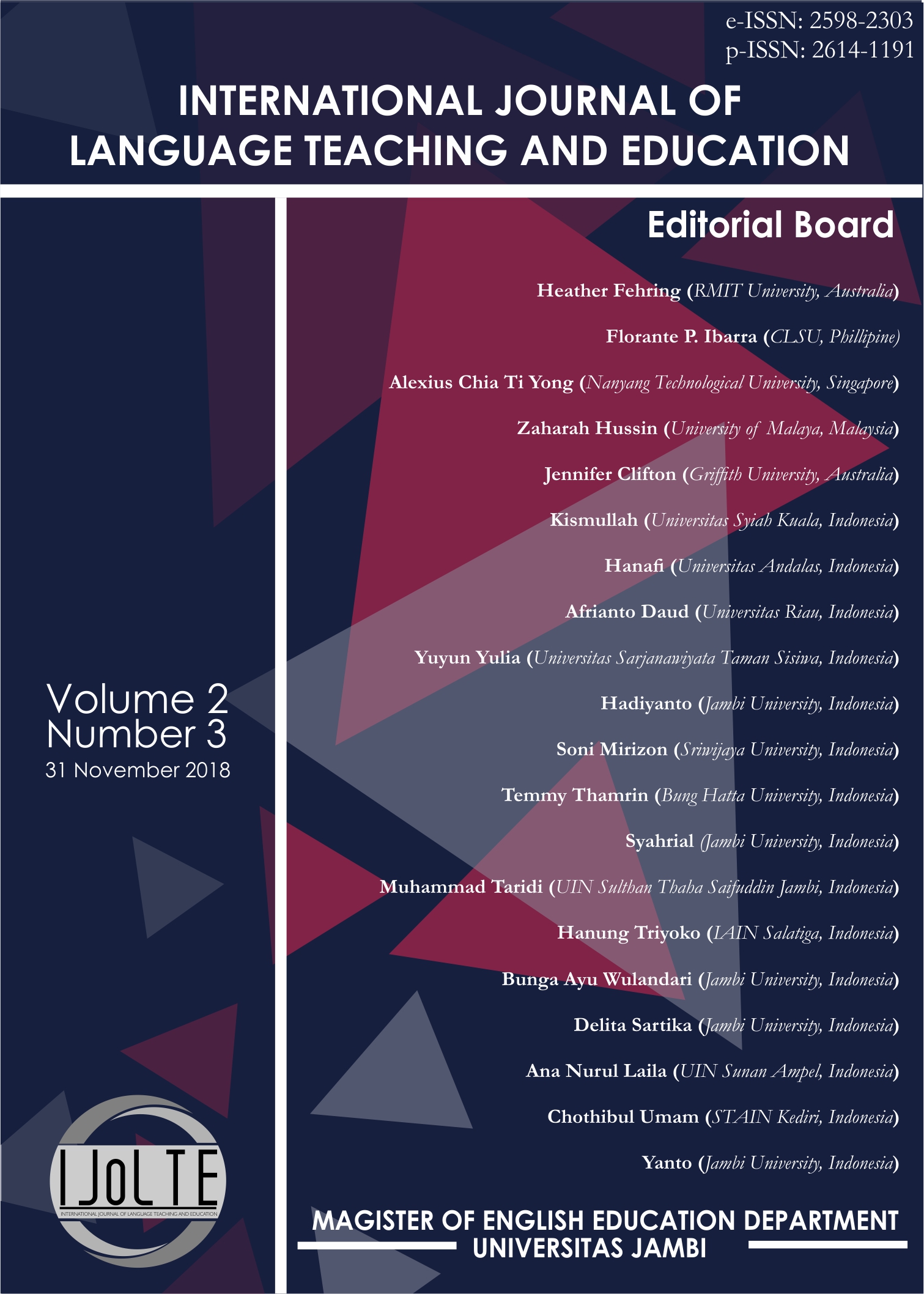Ideational Meanings of Teachers' Utterances in Reading and Writing Classes
DOI:
https://doi.org/10.22437/ijolte.v2i3.5689Keywords:
Ideational Meaning, processes, participants, reading and writing classesAbstract
This study is aimed at describing the ideational meanings of teachers’ utterances in Reading and Writing classes. It reveals what processes, participants and circumstances are found in the teachers’ utterances. The data were taken from the Reading and Writing classes conducted at a university in Semarang city. The data were collected by video recording the teaching and learning processes in Reading and Writing classes, then they were analyzed by segmenting the utterances into clauses; identifying the process, participants, and circumstances; classifying the processes, participants and circumstances based on their type; and interpreting the data. The results showed that the processes mostly found in the teachers’ utterances in Reading class are relational ones with carrier and attribute as participants, the second are mental processes with senser and phenomenon as the participants, while in those of Writing class are material with actor and goal as participants and the second are relational with carrier and attribute as participants. Relational processes are dominant in Reading class because the teacher explained many terms or vocabularies found in the text to make the students really understand them. That material processes are dominant in Writing class is caused by the fact that in Writing class the teacher often asks the students to do some actions like writing or doing something.
Downloads
References
[2] Watskins, P. (2004). Writing. English Teaching professional Issue, 30, 40-41.
[3] Lewitt, P.J. (1990). How to Cook a Tasty Essay. English Teaching Forum. Vol. 26, 17 – 23.
[4] Richards, J.C., & Renandya, W.A. (2002). Methodology in language teaching: An anthology of current practice. Cambridge: Cambridge University Press.
[5] Bull, G & Anstey, M (2010 a), Evolving Pedagogies; Reading and Writing in a Multimodal World, Education Services Australia, Melbourne.
[6] Halliday, M.A.K., & Matthiessen, C. (1994). Halliday’s introduction to functional grammar (fourth edition). London: Routledge.
[7] Kress, G. (2009). Multimodality: a Social Semiotic Approach to Contemporary Communication, London: Routledge.
[8] Martin, J., & Rose, D. (2003). Working with Discourse: Meaning beyond the clause. New York: Continuum.
[9] Gerot, Linda and Wignell, Peter. (1994). Making Sense of Functional Grammar. New South Wales: Gerd Stabler.
[10] Butt, D., Fahey, R., Spinks, S., &Yallops, C. (2001). Using functional grammar: An explorer’s guide (Second edition). Sydney: NCELTR, Macquarie University.
[11] Derewianka, Beverly. (1990). Exploring How Texts Work. Australia: Primary English Teaching Association
[12] Hammond, Jennifer and Derewianka, B. (2001). Genre. In Carter, R. And Nunan, D. The Cambridge Guide to Teaching English to Speakers of Other Language. (pp.186-193). Cambridge University Press.
[13] Hyland, Ken. (2004). Genre and Second Language Writing. USA: The University of Michigan Press.
[14] Alaei. Mahya, Ahangin. Saedah. 2016. A Study of Ideational Metafunction in Jo-seph Conrad’s Hearth of Darkness: A Critical Discourse Analysis. English Lan-guage Teaching Journal. Vol. 9 No. 4 2016. Canadian Center of Science and Edu-cation.
[15] Gusnawaty, Yastiana. Yuli, Yassi. Abdul Hakim. 2017. Ideational Meaning of Butonese Folklore: A Systemic Functional Linguistic Study. Rupkhata Journal on Interdisiplinary Studies in Humanities. Vol. IX No. 1.2017.
Downloads
Published
Versions
- 2018-12-01 (1)
- 2018-12-01 (1)
How to Cite
Issue
Section
License
The Authors submitting a manuscript do so on the understanding that if accepted for publication, copyright of the article shall be assigned to International Journal of Language Teaching and Education (IJoLTe) and Magister Program of English Education Department, Universitas Jambi as publisher of the journal. Copyright encompasses rights to reproduce and deliver the article in all form and media, including reprints, photographs, microfilms, and any other similar reproductions, as well as translations.
IJoLTe keep the rights to articles that have been published. And, the authors are permitted to disseminate published article by sharing the link of IJoLTe' website. Authors are allowed to use their works for any purposes deemed necessary without written permission from IJoLTe with an acknowledgement of initial publication in this journal.
IJoLTe and Magister Program of English Education Department, Universitas Jambi, and the Editors make every effort to ensure that no wrong or misleading data, opinions or statements be published in the journal. In any way, the contents of the articles and advertisements published in IJoLTe are the sole and responsibility of their respective authors and advertisers.
If the article was jointly prepared by more than one author, any authors who submitting the manuscript warrants that he/she has been authorized by all co-authors to be agreed on this copyright and license notice (agreement) on their behalf, and agrees to inform his/her co-authors of the terms of this policy. IJoLTe will not be held liable for anything that may arise due to the author(s) internal dispute. IJoLTe will only communicate with the corresponding author.
By submitting the article/manuscript to this journal, the authors agree with this policy and consciously agree that IJoLTe does not provide royalties or other fees to the authors for their published articles. By agreeing this policy, IJoLTe ensures that published articles are publicly accessible and will be free of charge for the readers. No specific document sign-off is required.
Users of this website will be licensed to use materials from this website following the Creative Commons Attribution 4.0 International License. Please use the materials accordingly
You are free to:
- Share — copy and redistribute the material in any medium or format
- Adapt — remix, transform, and build upon the material for any purpose, even commercially.
- The licensor cannot revoke these freedoms as long as you follow the license terms.








1.png)
